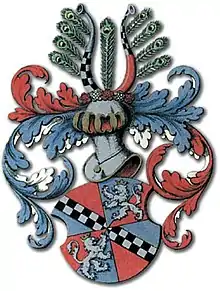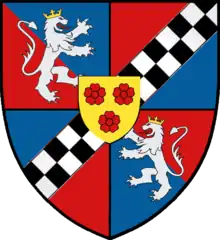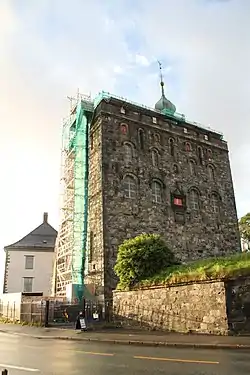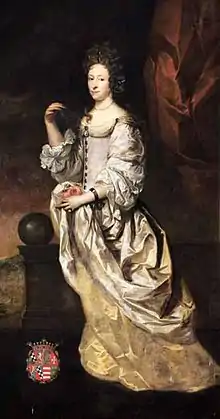Rosenkrantz (noble family)
Rosenkrantz (one line spelled Rosencrantz) is a Danish, Norwegian, and Swedish noble family. The family is known since the 14th century and belongs to the old nobility. It has played a prominent role in Denmark and Norway, its members having been estate owners as well as high officials.[1]


The surname appears in William Shakespeare's tragedy The Tragedy of Hamlet, Prince of Denmark (see Rosencrantz and Guildenstern). [2]
Rosenkrantz in Denmark
Rosenkrantz was initially Danish nobility with subsequent branches in both Norway and Sweden. The Yearbook of the Danish Nobility (Danmarks Adels Aarbog) operates with the following family lines:
Line I: Hevringholm
The Hevringholm line consists of the family's oldest known members in Vivild parish in Norddjurs. Period: c. 1300–1600.[3]
Line II: Boller with the so-called "legitimised line"
The Boller line, which includes the barons Rosenkrantz of Rosendal. This line emanated from line I with Erik Rosenkrantz (died 1503) marrying in 1456 Sophie Henriksdatter Gyldenstierne (1430-1477), the heiress of Boller. In 1618/1619 - five generations later - Holger Rosenkrantz (died 1638) sold Boller to Ellen Marsvin (1572- 1649), the widow of Ludvig Munk, who in 1607 married secondly Knud Rud, and whose daughter Kirsten Munk had in 1615 married King CHRISTIAN IV (1577-1648). The King made Ellen transfer Boller (and Rosenvold) to her sole child and daughter Kirsten Munk in 1630. The so-called "Legitimised Line" is an unnecessary creation, suggesting that it was illegitimate before; it was begun by the Boller-descendant Holger Rosenkrantz (1599-1634 Venlo), who was a soldier in Danish and Dutch service and apparently had been abroad for so long that no one remembered him so that his sons Ludvig (fief baron of Rosendal in 1678) and Maximilian (at Nyboellegaard) had to prove that Holger's father was Frederick Rosenkrantz (1571-1602 Moravia!) of the Boller line.
Line III: Arreskov
The Arreskov line descends from the Boller line Faaborg on Funen, when in 1558 Erik Rosnkrantz (1520 - 1575) married the heiress of Arreskov: Helvig Jacobsdatter Hardenberg (1540 - 1599).
Line IV: Rosenholm
The Rosenholm line also descends from the Boller line and consists of descendants of Jørgen Ottesen Rosenkrantz at Rosenholm (1523 - 1596). This line became extinct in the paternal line in 1802 with the death of Frederik Christian Rosenkrantz (1724-1802).[4]
Line V: Villestrup (baronial)
The baronial line of Villestrup, a side line of line IV. This line descends from Baron Werner Rosenkrantz til Villestrup (1700–1777), who in 1757 received the royal patent for this fief barony. The family seat Rosenholm was inherited by this line in 1802, and all present Danish members of the Rosenkrantz family, belong to this line.[5]
Line VI: Brusgaard / Barritskov
The Brusgaard /Barritskov line is also a side line of line IV. This line was founded by Holger Rosenkrantz (1645-1704). Niels Rosenkrantz (1757-1824) of the Brusgaard line had inherited Barritskov from Staatsminister Frederik Christian ROSENKRANTZ (Barritskov estate near Hedensted in Midtjylland, according to whose will it was transferred to the Rosenkrantz family estate. The line became extinct in 1838 with Marcus Giøe Rosenkrantz (1762–1838).[6] [7]
Line VII: Rydhave
Rydhave near Vinderup in Jutlanddescends from Stensballegaard, which in around 1440 descended from Hevringholm. The son of Axel Rosenkrantz (1472-1551) at Stensballegaard and Rydhave, Niels Rosenkrantz (1505-1581) inherited a part of Rydhave and subsequently acquired the parts of his brothers in 1551.[8]
Line VIII: Glimminge
The Glimminge line started from the Rydhave line with Erik Rosenkrantz (born 1516) marrying firstly in 1551 the heiress of Glimminge Skåne, Margrethe Boergesdatter Ulfstand (died 1582). Among his descendants were Holger Axelsen Rosenkrantz (1586-1647) of Glimmingehus etc. and Palle Rosenkrantz (1587-1642) of Krenkerup on Lolland, Noerregaard and Rosenlund. The line ended with Eleonore Gustaviane Rosenkrantz (1737-1825), when Glimminge had already been integrated into a fideimommiss.[9] [10]
Line IX: Older Scanian line
The older Scanian line (Ørup line) emanated from the Rydhave line, when Erik Rosenkrantz (born 1516) in 1551 married firstly Margrethe Ulfstand (see Rydhave). Oerup was inherited by his son Boerge (died 1614). The family remained on the Ørup estate after Skåne in 1660 was ceded to Sweden. Holger Rosenkrantz (1688–1758) was in 1752 naturalized as Swedish nobleman under the surname Rosencrantz. They seem to have held Oerup until 1840, the line continuing at least until the end of the 20th century [11]
Line X: Newer Scanian line
The newer Scanian line, which emanated from line IX in the beginning of the 18th century. Members of this family are still living in Sweden.
Line XI: Southern Jutlandic line / Soenderjyske linie at Kogsboel
The Southern Jutlandic line, which emanated from line I (Hevringholm) before 1355 (death of Erik Rosenkrantz at Hevringholm) and ended with the death after 1625 of Carsten Rosenkrantz at Gribsgaard, Kambo and Kogsboel, who outlived his son Bendix (died 1622).
Rosenkrantz in Norway

Rosenkrantz Tower
Rosenkrantz Tower (Rosenkrantztårnet) is located near Vågen in Bergen, Norway. Parts of the tower date back to the 1270s, but have been rebuilt several times. Erik Ottesen Rosenkrantz (1519-1575) was governor of Bergenhus Fortress from 1560 to 1568. In 1562, Rosenkrantz decided to build a combined defense and residence tower with five floors and facade towards Bryggen. The work was carried out by Scottish masons and the finished building had many common features with fortified Scottish towers of the time period. [12] [13][14]
Barony of Rosendal

The history of Rosendal dates back to the 1650s, when Ludwig Holgersen Rosenkrantz (1628–1685) came to Bergen as commissioner of war for the Danish king. At a ball at the fortress of Bergenhus, he met Karen Axelsdatter Mowat (1630–1675), sole heiress to the largest fortune in the country at the time. Her father Axel Mowat (1592–1661) was a great land-owner, and had more than 550 farms all over Western Norway. They married in 1658, and were subsequently given the farm Hatteberg in Rosendal in Kvinnherad as a wedding present. In 1661, Ludwig Rosenkrantz started building his own manor at Rosendal. He completed this in 1665. In 1678, King Christian V of Denmark gave the estate the status of Barony of Rosendal (Baroniet Rosendal). It was and remained the only fief barony in Norway. [15] [16] [17] [18]

 Baroness Karen Rosenkrantz, née Mowat
Baroness Karen Rosenkrantz, née Mowat Coat of arms of the Baron of Rosendal
Coat of arms of the Baron of Rosendal Coat of arms of Iver Rosenkrantz (born 1674)
Coat of arms of Iver Rosenkrantz (born 1674) Coat of arms of Anne Beate Rosenkrantz (1707–1777)
Coat of arms of Anne Beate Rosenkrantz (1707–1777)
Name
Rosenkrantz can be translated as rose wreath or rosary. The family's name appears to be derived from the coat of arms, in which we find a wreath of heraldic roses instead of the usual torse between the helm and the crest.
Coat of arms
_(selon_Gelre).svg.png.webp)
The standard arms of Rosenkrantz are party per bend gules and azure, a bend checky argent and sable. Above the helm and the wreath of roses, there is a peacock feather between two buffalo horns having four ditto feathers each. The horns are divided into silver and pattern, and pattern and red, respectively. The oldest known illustration of the standard arms is found in the Gelre Armorial of the 14th century.
See also
References
- Jon Gunnar Arntzen. "Rosenkrantz". Store norske leksikon. Retrieved July 1, 2017.
- (Charles Boyce (2005) Critical Companion to William Shakespeare: A Literary Reference to His Life and Work (Facts on File, Inc) ISBN 978-0816053735
- Karl Hansen (1832). "Hevringholm, Vivild sogn" (PDF). Danske Knidborge. Retrieved July 1, 2017.
- Carl Frederik Bricka. "Rosenkrantz, Frederik Christian, 1724-1802". Dansk biografisk Lexikon. Retrieved July 1, 2017.
- "Rosenkrantz". Den Store Danske. Retrieved July 1, 2017.
- "Barritskov". Danske Herregaarde. Retrieved July 1, 2017.
- Knut Dørum. "Marcus Gjøe Rosenkrantz". Store norske leksikon. Retrieved July 1, 2017.
- "Rydhave". Danske Herregaarde. Retrieved July 1, 2017.
- "Glimmingehus". Sverige Slottsguiden. Retrieved July 1, 2017.
- "Krenkerup". Den Store Danske. Retrieved July 1, 2017.
- "Örup". Nordisk familjebok. Retrieved July 1, 2017.
- "Rosenkrantztårnet". lokalhistoriewiki.no. Retrieved July 1, 2017.
- "Rosenkrantztårnet". Store norske leksikon. Retrieved July 1, 2017.
- Erik Opsahl. "Erik Ottesen Rosenkrantz". Store norske leksikon. Retrieved July 1, 2017.
- Anders Bjarne Fossen. "Ludvig Rosenkrantz Til Rosendal". Norsk biografisk leksikon. Retrieved July 1, 2017.
- Anders Bjarne Fossen. "Karen Mowat". Norsk biografisk leksikon. Retrieved July 1, 2017.
- Anders Bjarne Fossen. "Axel Mowat Til Hovland". Norsk biografisk leksikon. Retrieved July 1, 2017.
- Jon Gunnar Arntzen. "Baroniet Rosendal". Store norske leksikon. Retrieved July 1, 2017.
| Wikimedia Commons has media related to Rosenkrantz family. |
Literature and sources
- Wikipedia, Danish: Rosenkrantz (Per 11 April 2011.)
- Wikipedia, Norwegian Bokmål & Riksmål: Rosenkrantz (Per 11 April 2011.)
- Wikipedia, Norwegian Bokmål & Riksmål: Baroniet Rosendal (Per 11 April 2011.)
- Wikipedia, English: Barony Rosendal (Per 11 April 2011.)